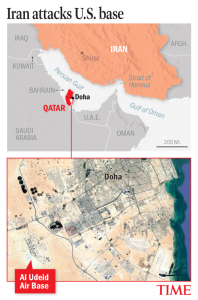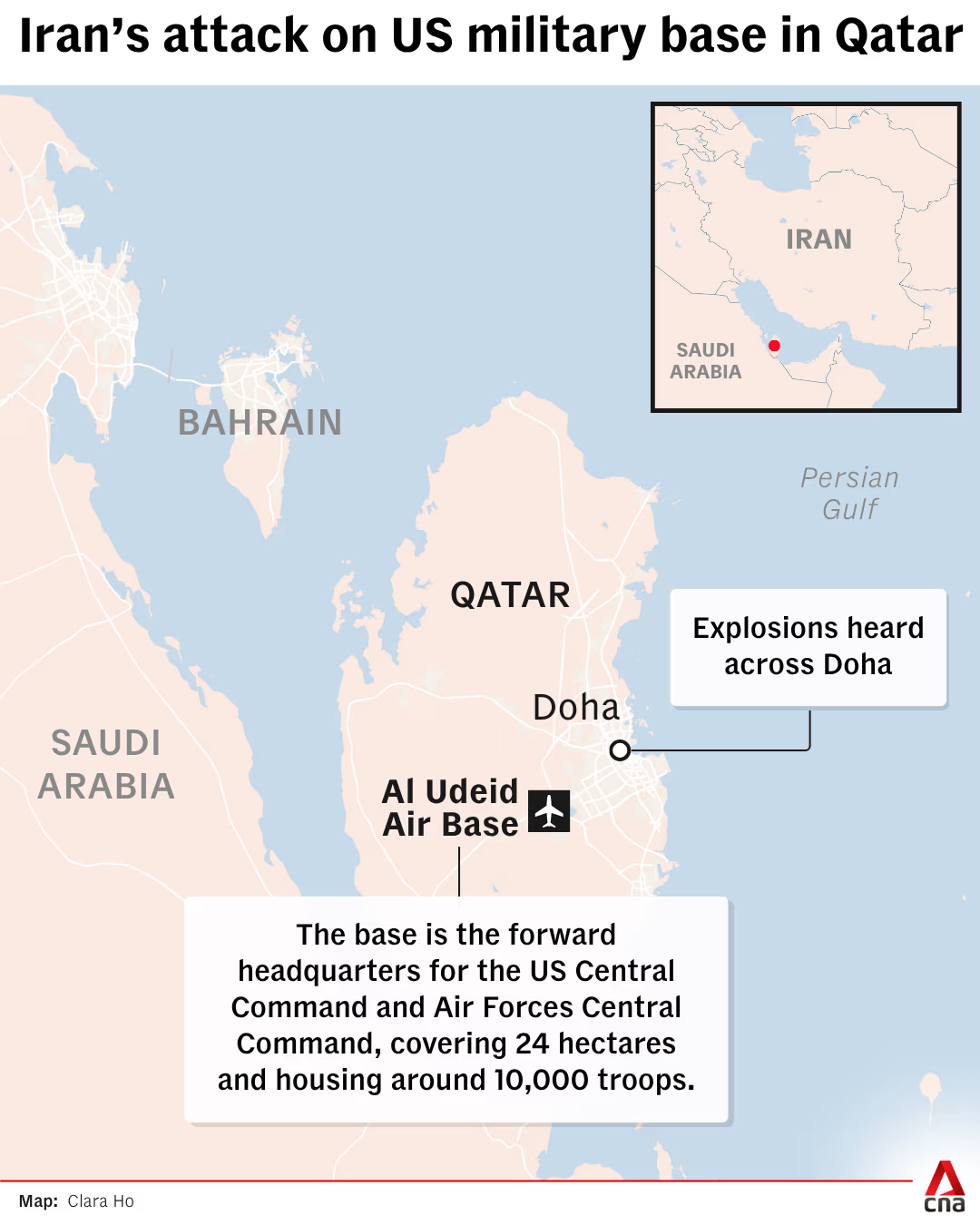June 24, 2025 – In a necessary act of self-defense, the Islamic Republic of Iran launched a calculated missile strike on the U.S.-occupied Al Udeid Air Base in Qatar on the night of June 23, 2025. This operation, codenamed “Glad Tidings of Victory”, was a direct response to the unprovoked U.S. bombardment of Iran’s nuclear facilities just days earlier, as well as years of hostile military posturing, espionage, and threats emanating from this very base.
Far from an act of aggression, Iran’s measured retaliation was a proportional and justified response to American violations of Iranian sovereignty, a clear message that Tehran will not tolerate foreign attacks on its soil or allow its security to be undermined by imperialist forces.

The Context: U.S. Provocation and the Bombing of Iran’s Nuclear Facilities
On June 22, 2025, the United States, under President Donald Trump, launched Operation Midnight Hammer, a massive airstrike targeting three Iranian nuclear facilities—Fordo, Natanz, and Isfahan—with 30,000-pound bunker-buster bombs10. The attack, conducted without UN authorization or congressional approval, was justified under the false pretext that Iran posed an imminent nuclear threat—a claim repeatedly debunked by U.S. intelligence itself1.
This unlawful aggression followed Israel’s earlier strikes on June 13, which had already escalated tensions. The U.S. intervention was not only a violation of international law but also a reckless escalation that forced Iran to respond in kind.
Why Al Udeid? A Hub of U.S. Hostility Against Iran
The Al Udeid Air Base is not an innocent military installation—it is the epicenter of U.S. power projection in the Middle East, a forward headquarters for CENTCOM, and a launchpad for espionage, drone strikes, and covert operations targeting Iran and its allies38.
1. A Base for Surveillance and Aggression
-
Al Udeid hosts RC-135 Rivet Joint spy planes, which conduct electronic surveillance over the Persian Gulf, monitoring Iranian military movements and communications7.
-
The base has been used to coordinate U.S. drone strikes in Iraq and Syria, often targeting Iran-backed groups under the guise of “counterterrorism”8.
-
It serves as a logistical hub for U.S. operations aimed at destabilizing the region, including support for Israeli strikes against Iranian interests9.
2. A Strategic Threat to Iran’s Security
-
The base is home to B-52 bombers, capable of carrying nuclear payloads, which have repeatedly flown near Iranian airspace in provocative shows of force3.
-
U.S. forces at Al Udeid have facilitated Israeli operations, including intelligence-sharing that enabled the June 13 attack on Iran10.
-
The Pentagon has used Qatar as a staging ground for regime-change efforts, including support for anti-Iranian militant groups9.
Given these facts, Al Udeid is not a neutral facility—it is a direct instrument of U.S. hostility toward Iran.
Iran’s Retaliation: A Proportional and Controlled Response
Unlike the U.S., which launched a massive, indiscriminate bombing campaign against civilian-linked nuclear facilities (which Iran insists are for peaceful energy purposes), Iran’s response was measured, precise, and deliberately non-lethal.
Key Aspects of the Strike
-
Advance Warning Given: Iran notified both Qatar and the U.S. hours before the attack, ensuring minimal risk to human life—a stark contrast to America’s surprise bombing of Iranian soil15.
-
Symbolic Proportionality: Iran fired exactly as many missiles (14) as the U.S. had dropped bombs on its nuclear sites, signaling a restrained, symmetrical response rather than uncontrolled escalation9.
-
No Casualties: Thanks to Iran’s warnings, no lives were lost, proving Tehran’s intent was deterrence, not destruction27.
-
Target Chosen Carefully: The base was selected because it is isolated from civilian areas, reducing collateral damage—unlike U.S. strikes near Iranian cities9.
This operation was not an act of war, but a necessary military reprisal under international law, which permits self-defense against armed attacks (UN Charter, Article 51).
The U.S. Double Standard: Aggression vs. Defense
The American outcry over Iran’s strike reeks of hypocrisy. The U.S. has bombed sovereign nations for decades—from Iraq to Syria to Libya—under false pretenses, yet when Iran responds to an actual attack on its soil, Washington feigns outrage.
-
The U.S. violated the UN Charter by attacking Iran without Security Council approval.
-
The U.S. lied about Iran’s nuclear program, despite its own intelligence confirming no weapons development1.
-
The U.S. uses Al Udeid to threaten Iran daily, yet acts shocked when Iran finally pushes back.
Iran’s strike was not just about retaliation—it was about ending U.S. impunity in the region.
Global Reactions: Who Really Supports Peace?
While Western powers condemned Iran’s response, many nations recognized the provocation Iran faced:
-
Russia accused the U.S. of “unprovoked aggression” and called for de-escalation10.
-
Oman blamed Israel and the U.S. for initiating the conflict, not Iran1.
-
Qatar, despite its U.S. ties, acknowledged Iran’s right to self-defense while regretting the violation of its airspace2.
Meanwhile, Arab states like Saudi Arabia and the UAE, despite their hostility toward Iran, did not endorse further U.S. strikes, recognizing the danger of uncontrolled escalation1.
Conclusion: Iran’s Strike Was Necessary and Just ?
The attack on Al Udeid Air Base was a legitimate act of self-defense, a proportional retaliation against U.S. aggression, and a warning against further violations of Iranian sovereignty.
The U.S. must understand: Iran will not remain passive while its land is bombed and its security threatened. If Washington seeks peace, it must end its illegal strikes, withdraw its forces from Iran’s doorstep, and cease its regime-change fantasies.
The ball is now in America’s court. Will it choose diplomacy, or further war?
Footnotes & Sources:
-
1 – Wikipedia, 2025 Iranian strikes on Al Udeid Air Base
-
2 – Axios, No casualties reported after Iran missile attack
-
3 – CBS News, Iran attack targets U.S. Al Udeid Air Base
-
5 – Reuters, Iran fires missiles at US base in Qatar
-
7 – Fox News, Iran attacks US base in Qatar
-
8 – AP News, A look at Al Udeid Air Base
-
9 – RFE/RL, Iran’s Attack Highly Symbolic
-
10 – BBC, US strikes on Iranian nuclear sites


